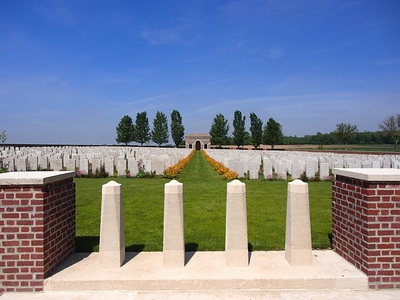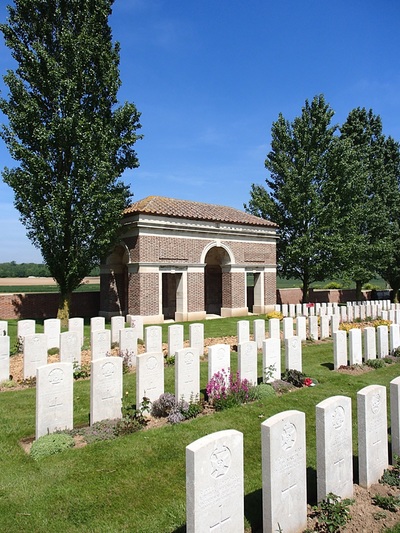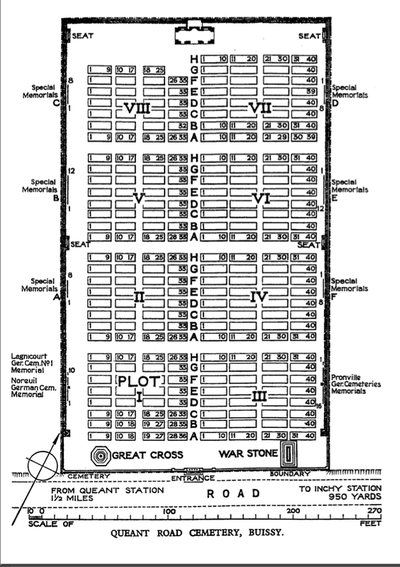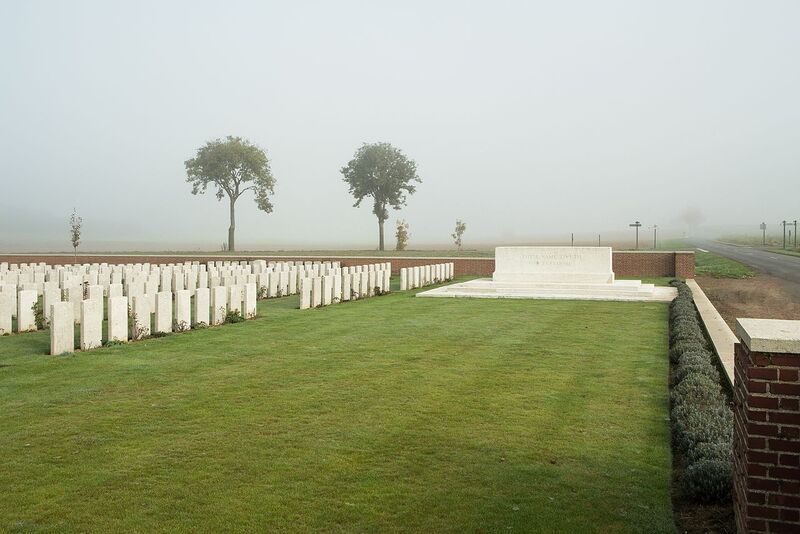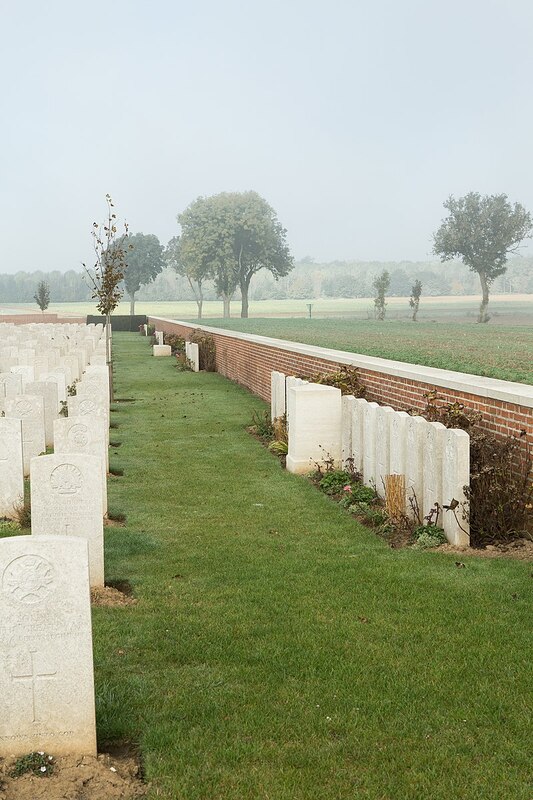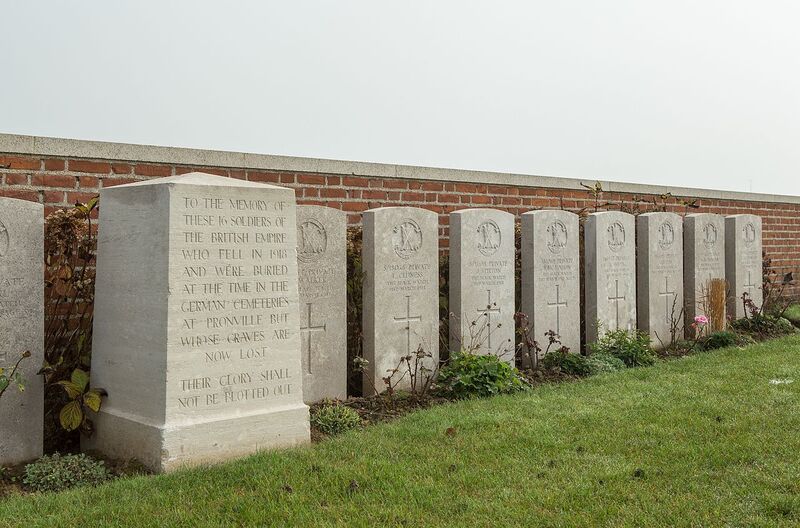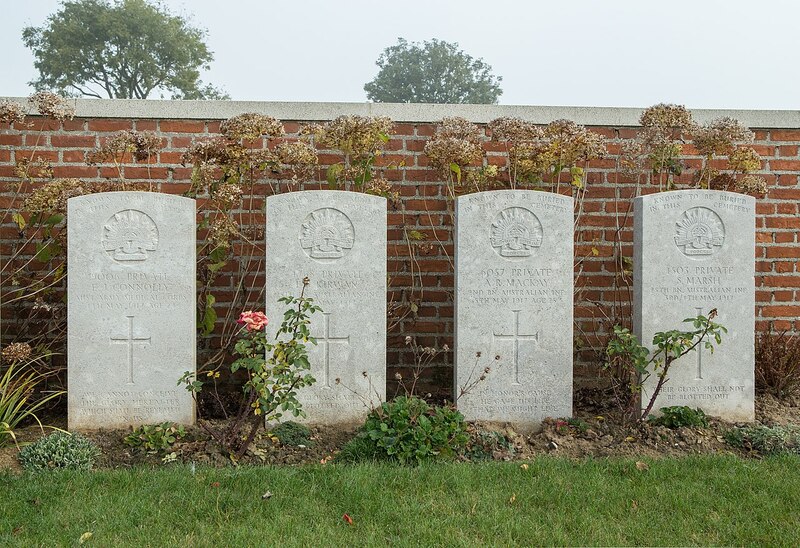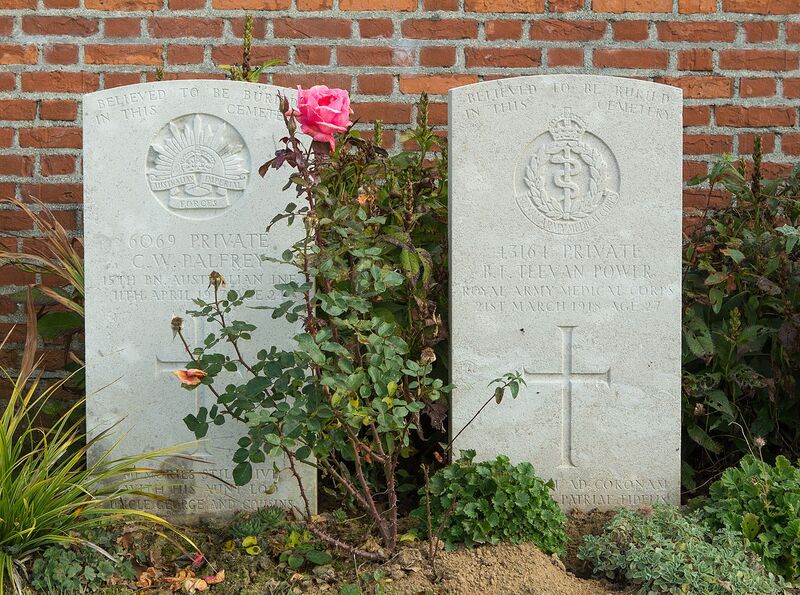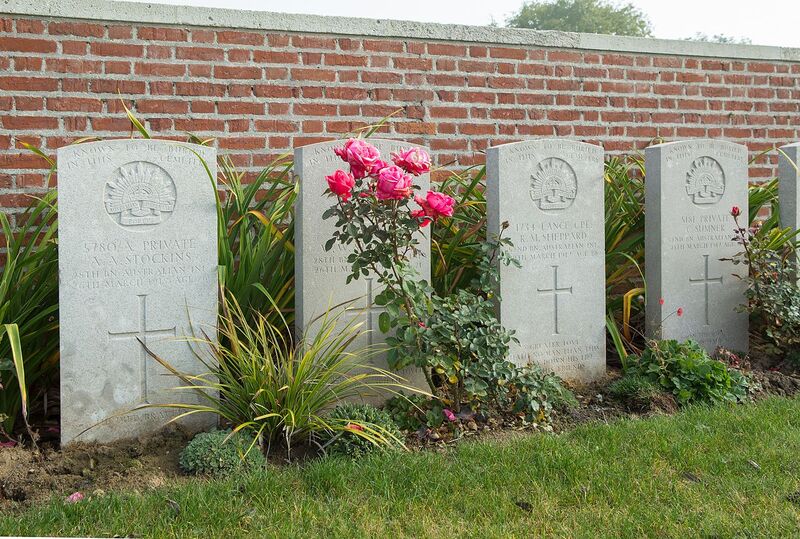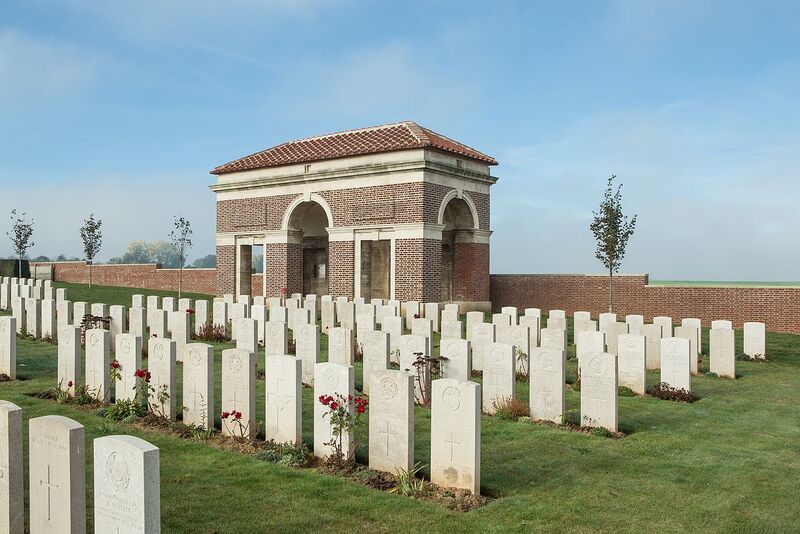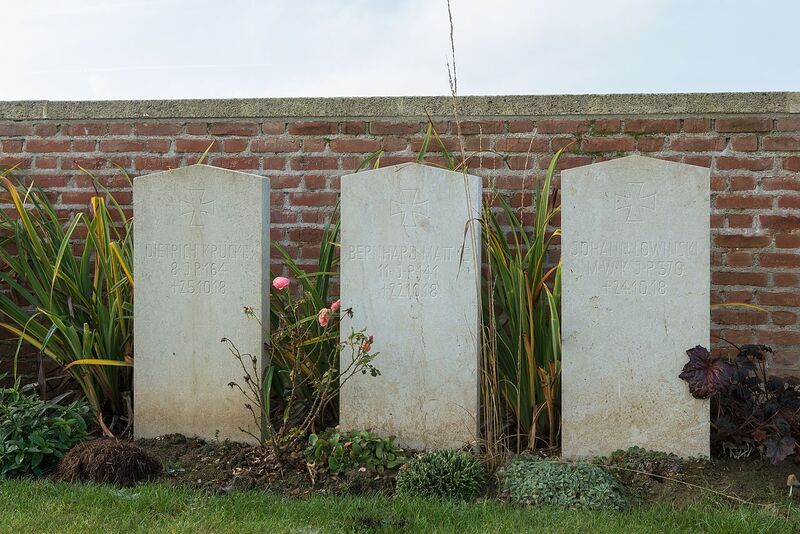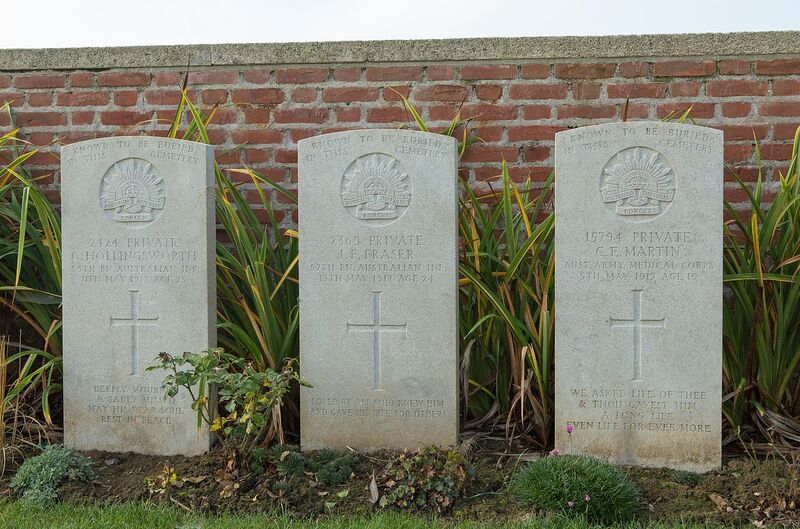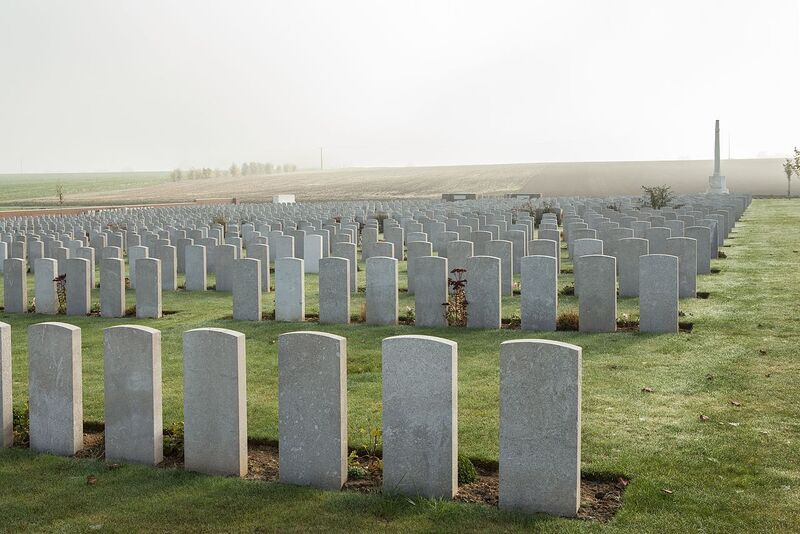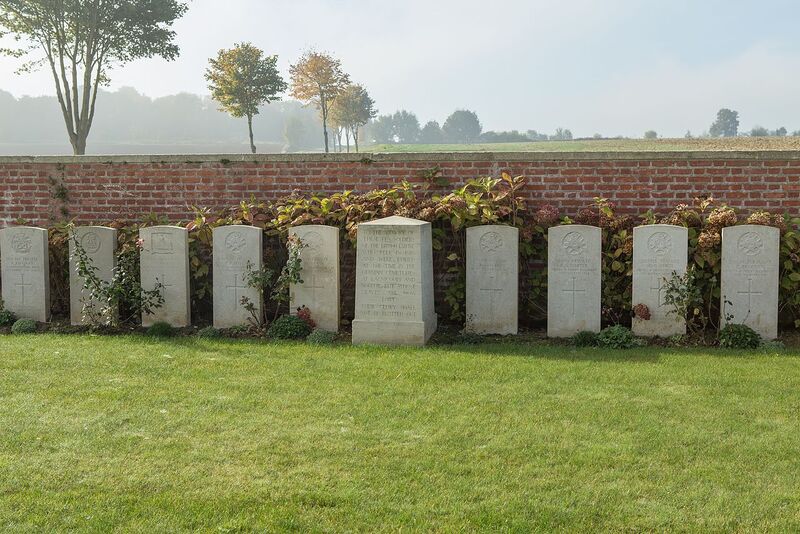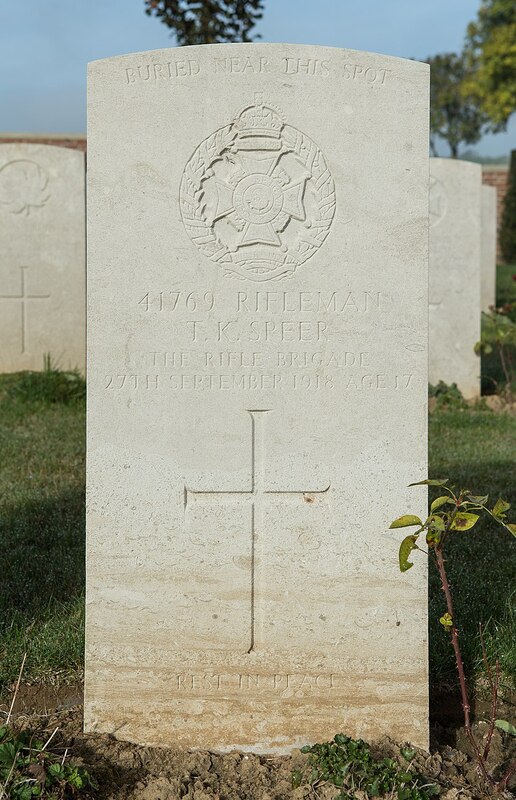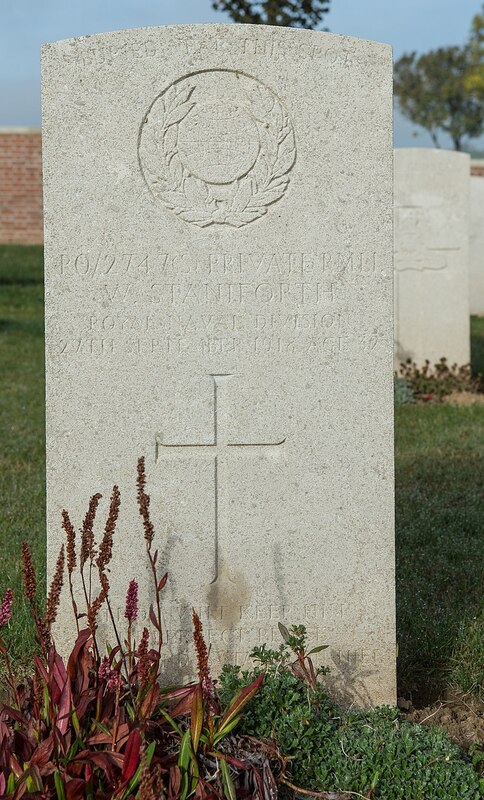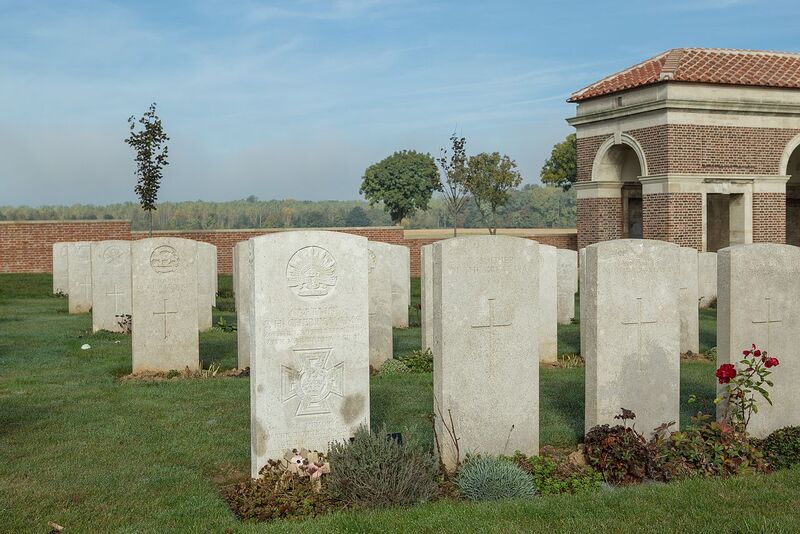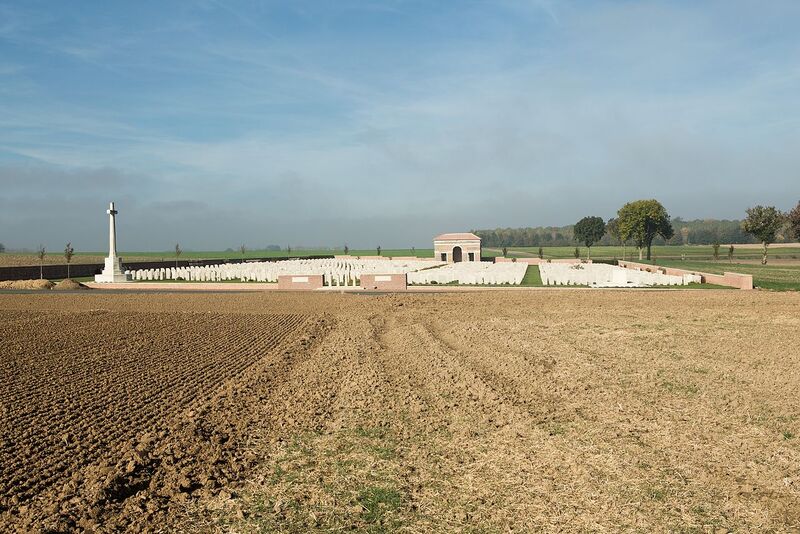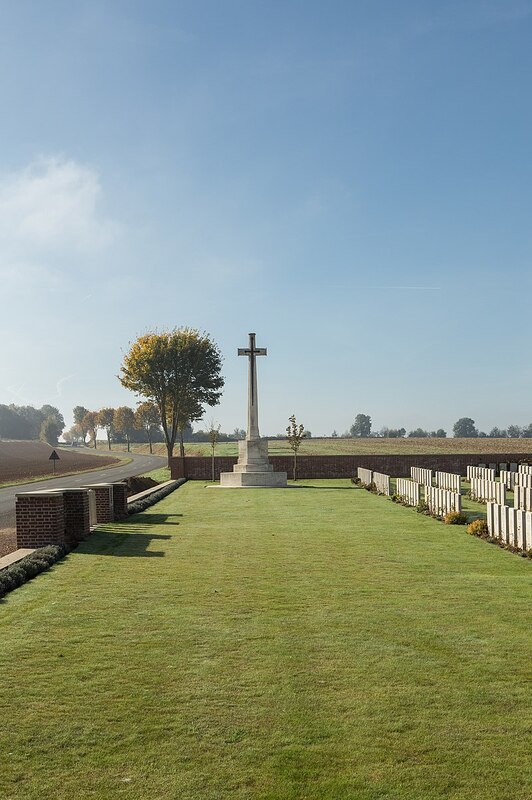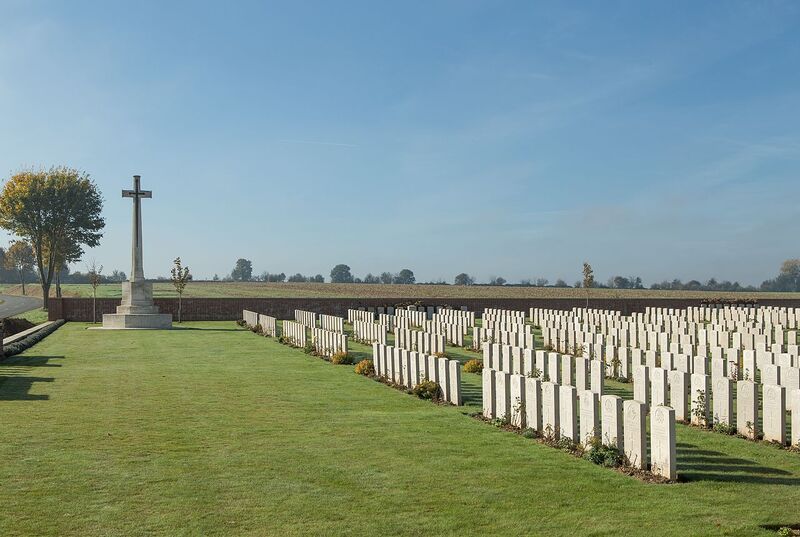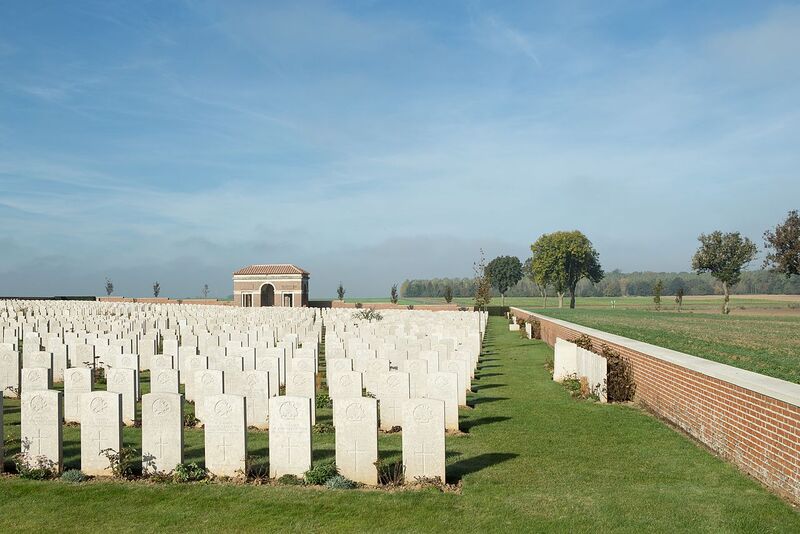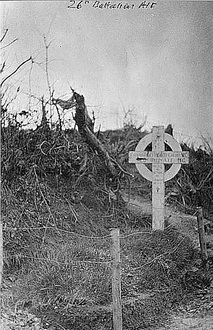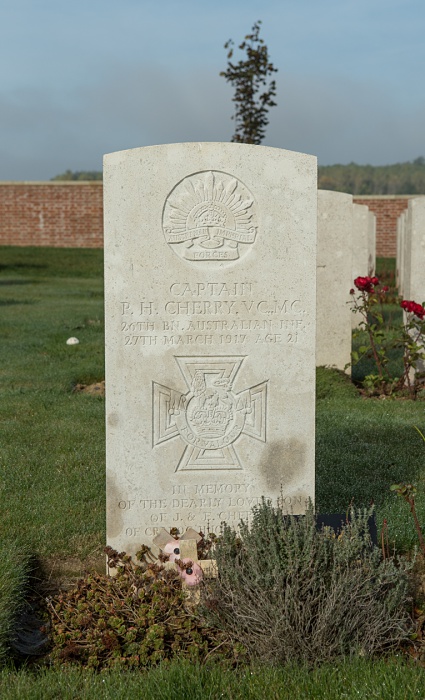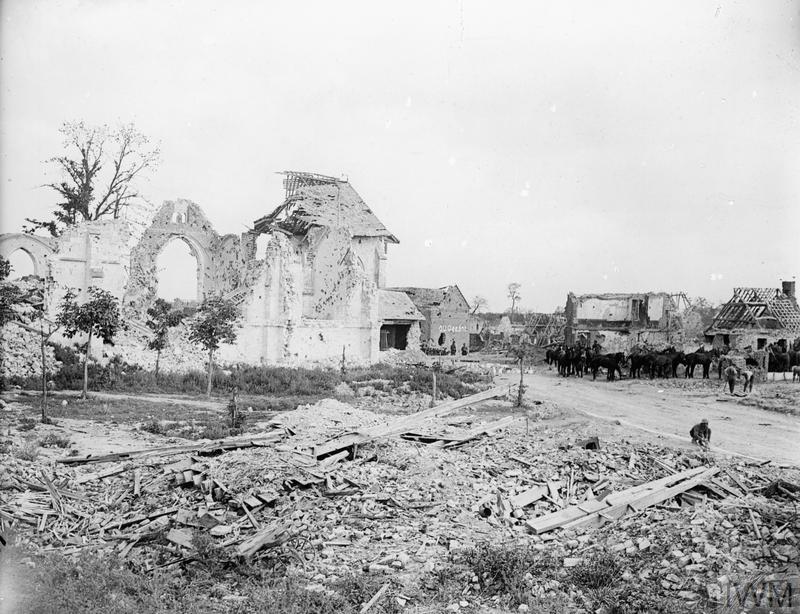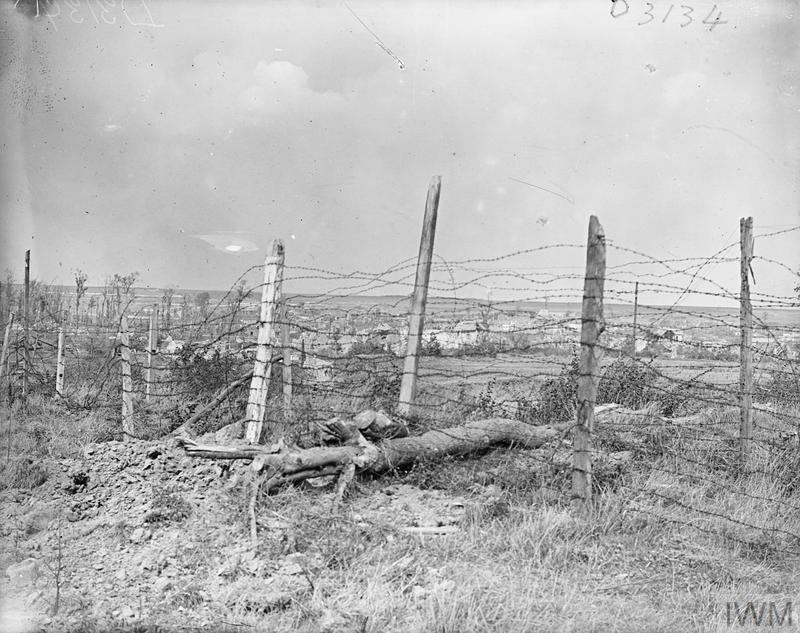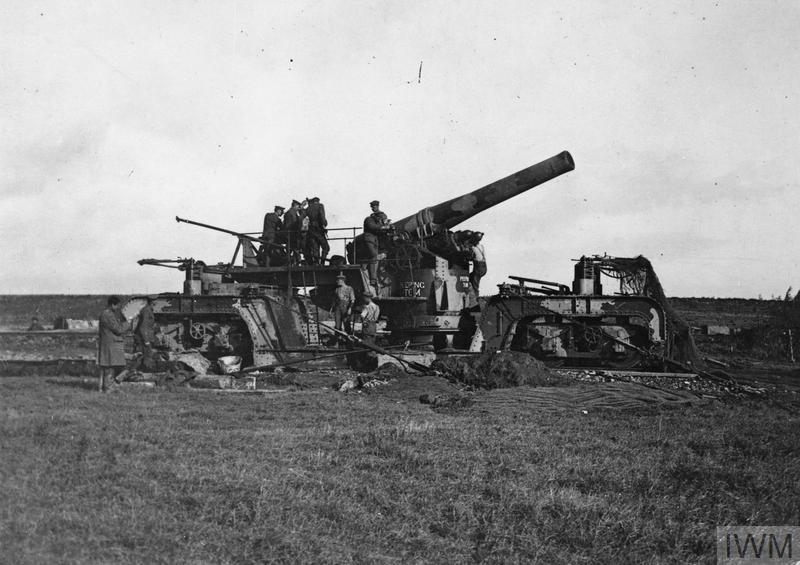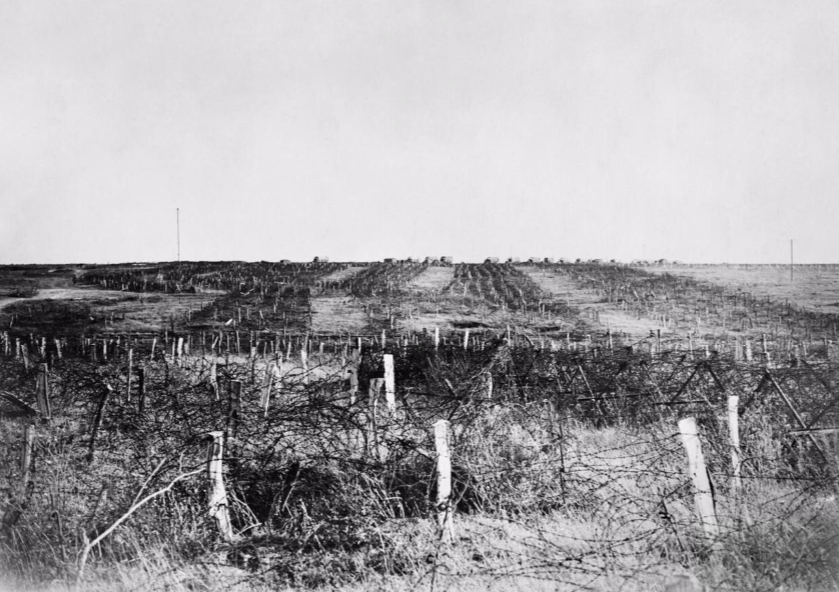QUÉANT ROAD CEMETERY
Buissy
Pas De Calais
France
Roll of Honour
Listed by Surname
Location Information
Buissy is a village about 2 kilometres south of the main Arras to Cambrai road (D939) and about 25 kilometres from Arras.
Queant Road Cemetery is situated on the north side of the D14 road that leads from the village towards Queant, about 3 kilometres from Buissy.
Visiting Information
Wheelchair access to this site is possible, but may be by alternative entrance.
Historical Information
Buissy was reached by the Third Army on 2 September 1918, after the storming of the Drocourt-Queant line, and it was evacuated by the Germans on the following day.
Queant Cemetery was made by the 2nd and 57th Casualty Clearing Stations in October and November 1918. It then consisted of 71 graves (now Plot I, Rows A and B), but was greatly enlarged after the Armistice when 2200 graves were brought in from the battlefields of 1917-1918 between Arras and Bapaume, and from the following smaller burial grounds in the area:-
BARALLE COMMUNAL CEMETERY BRITISH EXTENSION, which was made in September 1918, contained the graves of 25 soldiers from the United Kingdom; and the GERMAN EXTENSION, from which two graves were brought.
CAGNICOURT COMMUNAL CEMETERY, contained the grave of one soldier from the United Kingdom who fell in September 1918.
LAGNICOURT (6th JAEGER REGIMENT) GERMAN CEMETERY, East of the village, contained 137 German graves and one British.
NOREUIL BRITISH CEMETERIES No.1 and No.2. These were close together, about 400 metres North of Noreuil village. They were made in April-August 1917, and they contained the graves of 50 soldiers from Australia and 16 from the United Kingdom (some of these were re-buried in H.A.C. Cemetery, Ecoust-St. Mein).
NOREUIL GERMAN CEMETERY No.1, next to Noreuil Australian Cemetery, contained 78 German graves and ten British.
PRONVILLE GERMAN CEMETERY "near the Cave", on the Western outskirts of Pronville, contained 17 British graves.
PRONVILLE GERMAN CEMETERY No.4, South of Pronville on the road to Beaumetz, contained 83 German and 83 British graves (52 of the British being those of soldiers of the Black Watch).
PROVILLE CHURCHYARD, contained two British graves.
There are now 2,377 Commonwealth servicemen of the First World War buried or commemorated in this cemetery. 1,441 of the burials are unidentified, but there are special memorials to 56 casualties known or believed to be buried among them. Other special memorials commemorate 26 casualties buried in German cemeteries in the neighbourhood, whose graves could not be found on concentration.
Casualty Details: UK 1289, Canada 87, Australia 995, New Zealand 1, Unidentified 5, Total Burials: 2377.
The cemetery was designed by Sir Edwin Lutyens and George Hartley Goldsmith
Buissy is a village about 2 kilometres south of the main Arras to Cambrai road (D939) and about 25 kilometres from Arras.
Queant Road Cemetery is situated on the north side of the D14 road that leads from the village towards Queant, about 3 kilometres from Buissy.
Visiting Information
Wheelchair access to this site is possible, but may be by alternative entrance.
Historical Information
Buissy was reached by the Third Army on 2 September 1918, after the storming of the Drocourt-Queant line, and it was evacuated by the Germans on the following day.
Queant Cemetery was made by the 2nd and 57th Casualty Clearing Stations in October and November 1918. It then consisted of 71 graves (now Plot I, Rows A and B), but was greatly enlarged after the Armistice when 2200 graves were brought in from the battlefields of 1917-1918 between Arras and Bapaume, and from the following smaller burial grounds in the area:-
BARALLE COMMUNAL CEMETERY BRITISH EXTENSION, which was made in September 1918, contained the graves of 25 soldiers from the United Kingdom; and the GERMAN EXTENSION, from which two graves were brought.
CAGNICOURT COMMUNAL CEMETERY, contained the grave of one soldier from the United Kingdom who fell in September 1918.
LAGNICOURT (6th JAEGER REGIMENT) GERMAN CEMETERY, East of the village, contained 137 German graves and one British.
NOREUIL BRITISH CEMETERIES No.1 and No.2. These were close together, about 400 metres North of Noreuil village. They were made in April-August 1917, and they contained the graves of 50 soldiers from Australia and 16 from the United Kingdom (some of these were re-buried in H.A.C. Cemetery, Ecoust-St. Mein).
NOREUIL GERMAN CEMETERY No.1, next to Noreuil Australian Cemetery, contained 78 German graves and ten British.
PRONVILLE GERMAN CEMETERY "near the Cave", on the Western outskirts of Pronville, contained 17 British graves.
PRONVILLE GERMAN CEMETERY No.4, South of Pronville on the road to Beaumetz, contained 83 German and 83 British graves (52 of the British being those of soldiers of the Black Watch).
PROVILLE CHURCHYARD, contained two British graves.
There are now 2,377 Commonwealth servicemen of the First World War buried or commemorated in this cemetery. 1,441 of the burials are unidentified, but there are special memorials to 56 casualties known or believed to be buried among them. Other special memorials commemorate 26 casualties buried in German cemeteries in the neighbourhood, whose graves could not be found on concentration.
Casualty Details: UK 1289, Canada 87, Australia 995, New Zealand 1, Unidentified 5, Total Burials: 2377.
The cemetery was designed by Sir Edwin Lutyens and George Hartley Goldsmith
Images in this gallery © Werner Van Caneghem

Captain Percy Herbert Cherry, V. C., M. C.
26th Bn. Australian Infantry, Australian Infantry Force, killed in action 27th March 1917, aged 21. Plot VIII. C. 10.
Son of John Gawley Cherry and Elizabeth Cherry, of Cradoc, Huon, Tasmania. Born at Drysdale, Victoria.
Citation: An extract from the "London Gazette," dated 11th May, 1917, records the following:-"For most conspicuous bravery, determination and leadership when in command of a company detailed to storm and clear a village. After all the officers of his company had become casualties he carried on with care and determination in the face of fierce opposition, and cleared the village of the enemy. He sent frequent reports of progress made, and when held up for some time by an enemy strong point, he organised machine gun and bomb parties and captured the position. His leadership, coolness and bravery set a wonderful example to his men. Having cleared the village, he took charge of the situation and beat off the most resolute and heavy counter-attacks made by the enemy. Wounded about 6.30 a.m., he refused to leave his post, and there remained, encouraging all to hold out at all costs, until, about 4.30 p.m. this very gallant officer was killed by an enemy shell."
Click on pictures below to enlarge
26th Bn. Australian Infantry, Australian Infantry Force, killed in action 27th March 1917, aged 21. Plot VIII. C. 10.
Son of John Gawley Cherry and Elizabeth Cherry, of Cradoc, Huon, Tasmania. Born at Drysdale, Victoria.
Citation: An extract from the "London Gazette," dated 11th May, 1917, records the following:-"For most conspicuous bravery, determination and leadership when in command of a company detailed to storm and clear a village. After all the officers of his company had become casualties he carried on with care and determination in the face of fierce opposition, and cleared the village of the enemy. He sent frequent reports of progress made, and when held up for some time by an enemy strong point, he organised machine gun and bomb parties and captured the position. His leadership, coolness and bravery set a wonderful example to his men. Having cleared the village, he took charge of the situation and beat off the most resolute and heavy counter-attacks made by the enemy. Wounded about 6.30 a.m., he refused to leave his post, and there remained, encouraging all to hold out at all costs, until, about 4.30 p.m. this very gallant officer was killed by an enemy shell."
Click on pictures below to enlarge
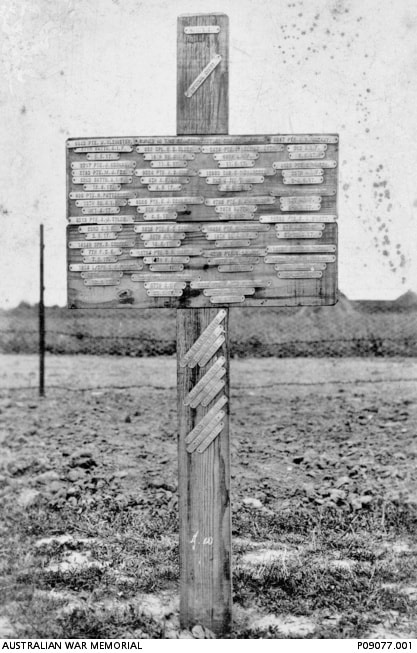
A wooden grave marker erected by the Commonwealth War Graves Commission at the Queant Road Cemetery, Buissy, France. The two metal tags on the top vertical post read: "C.W.G.C./ Special Cross" . The wooden board carries the heading "Buried in this cemetery actual graves unknown" and names 28 Australian soldiers killed in action in France between March and May 1917, and their date of death. Left column, from the top: 5843 Private (Pte) Walter Glenister, 27th Battalion, 5 May 1917; 2717 Pte John McGillicuddy Noonan, 52nd Battalion, 12 April 1917, 2783 Pte Michael James Fox, 52nd Battalion, 12 April 1917; 899 Pte Ross Patterson, 13th Battalion, 11 April 1917; 4013 Pte Albert Joseph Tyler, 23rd Battalion, 3 May 1917; 14549 Sapper George Collis, 7th Field Company Engineers, 7 May 1917; 1804 Lance Corporal Lawrence Plant, 58th Battalion, 12 May 1917.
Second column, from the top: 652 Pte Hubert Clement Clues, 16th Battalion, 11 April 1917; 9024 Pte Herbert Selby King, 6th Field Ambulance, 4 May 1917; 9006 Pte Eugene John Connolly, 5th Field Ambulance, 4 May 1917; 2638 Pte Ernest George Casey, 55th Battalion, 14 May 1917; 15794 Pte Cyril Everard Martin, 14th Field Ambulance, 5 May 1917; 2369 Pte James Foster Fraser, 57th Battalion, 13 May 1917;
Third column, from the top: 2424 Pte Clyde Hollingsworth, 55th Battalion, 11 May 1917; 12903 Gunner Claude Richardson, 2nd Divisional Trench Mortar Battery, 3 May 1917; 4768 Pte Edward John Kirwan, 28th Battalion, 3 May 1917; 4454 Pte Richard Johnson, 19th Battalion, 4 May 1917; 4219 Pte Thomas Savage, 25th Battalion, 8 May 1917; 3094 Pte Henry William James Fleming, 4th Battalion, 6 May 1917.
Fourth column, from the top: 6057 Pte Alexander Roy Mackay, 2nd Batttalion, 5 May 1917; 4503 Pte Sydney Marsh, 25th Battalion, 3-4 May 1917; 6306 Pte James Savage, 1st Battalion, 5-8 May 1917; 15580 Pte George William Swett, 6th Field Ambulance, 21-22 April 1917; 14581 Pte Charles Henry Thorn, 6th Field Ambulance, 21-22 April 1917; 16128 Joseph William Elms, 6th Field Ambulance, 21-22 April 1917.
Lower vertical post, from the top: 5889 Pte Arthur Charles Tepper, 23rd Battalion, 23 April 1917; 6039 Pte James Hogan, 3rd Battalion, 3 May 1917; 245 Corporal Cyril White, 27th Battalion, 26 March 1917.



